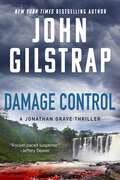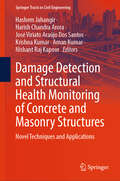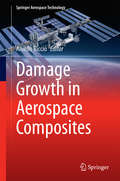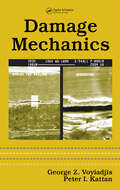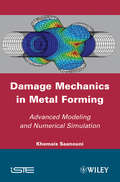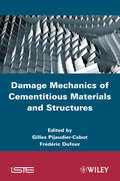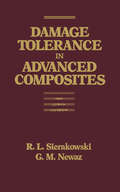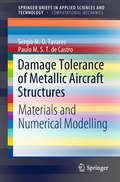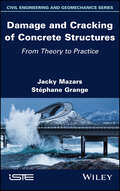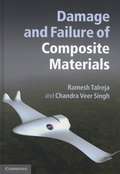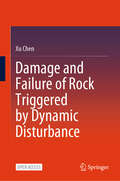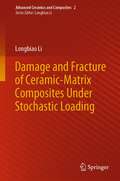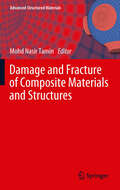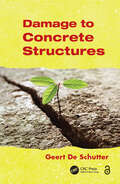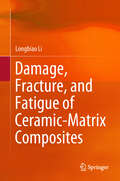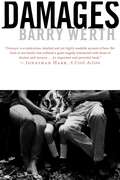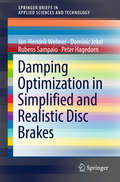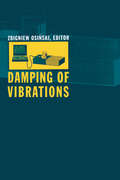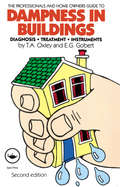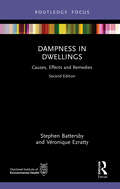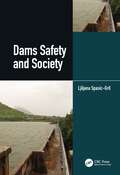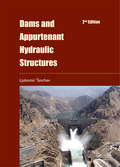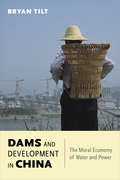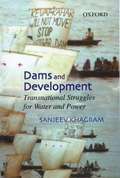- Table View
- List View
Dam and Levee Safety and Community Resilience
by Committee on Integrating Dam Levee Safety Community ResilienceAlthough advances in engineering can reduce the risk of dam and levee failure, some failures will still occur. Such events cause impacts on social and physical infrastructure that extend far beyond the flood zone. Broadening dam and levee safety programs to consider community- and regional-level priorities in decision making can help reduce the risk of, and increase community resilience to, potential dam and levee failures. Collaboration between dam and levee safety professionals at all levels, persons and property owners at direct risk, members of the wider economy, and the social and environmental networks in a community would allow all stakeholders to understand risks, shared needs, and opportunities, and make more informed decisions related to dam and levee infrastructure and community resilience. Dam and Levee Safety and Community Resilience: A Vision for Future Practice explains that fundamental shifts in safety culture will be necessary to integrate the concepts of resilience into dam and levee safety programs.
Damage Control (A Jonathan Grave Thriller #4)
by John GilstrapA hostage crisis in Mexico turns into a deadly game of cat and mouse in this international thriller by the New York Times bestselling author. They were on a mission trip to Mexico to help with earthquake recovery. But in Ciudad Juarez, the busload of well-meaning adults and teenagers became hostages. The ransom demands of their captors are explicit: deliver three million dollars--with zero involvement from law enforcement--or all captives will be executed. But rescue specialist Jonathan Grave doesn't believe in ultimatums. For Grave and his elite team at Security Solutions, it's all about protecting the innocent. When the delicate situation explodes in violence, he must flee with the survivors. Now Grave must face the chilling possibility that someone within the U.S. government has a deadly secret to protect--one that could jeopardize national security like never before. . .&“The action is nonstop. Gilstrap knows his technology and weaponry. Damage Control will blow you away.&”—Suspense Magazine
Damage Detection and Structural Health Monitoring of Concrete and Masonry Structures: Novel Techniques and Applications (Springer Tracts in Civil Engineering)
by Krishna Kumar Aman Kumar Hashem Jahangir Harish Chandra Arora José Viriato Araújo Dos Santos Nishant Raj KapoorThis book offers the use of artificial intelligence, image processing, model analysis, laser scanners, shearography, drones, contourlet, wavelet, signal processing techniques and other SHM techniques to detect the damages in the concrete as well as masonry structures. Corrosion is one major factor that causes reinforced concrete structures to deteriorate over time. However, the degrading process is not evenly distributed throughout the structure. The damage can be detected timely and the structure's degradation model can be updated with the help of proper monitoring and inspection techniques. The damages in the masonry structures may happen due to moisture ingress, cracking, mortar failure, settlement and spalling, etc. Structure health monitoring (SHM) may assist in understanding the structures deterioration mechanisms and reducing the ongoing deterioration in a scientific manner. A complete detail of both the traditional and cutting-edge approaches used in the SHM process is described in this book. The latest non-destructive techniques and semi-destructive techniques shall also be discussed in this book. This book aids academics and industry professionals with recent developments in SHM techniques. Additionally, it encourages researchers in coming up with creation of newer applications in structural engineering.
Damage Growth in Aerospace Composites (Springer Aerospace Technology)
by Aniello RiccioThis book presents novel methods for the simulation of damage evolution in aerospace composites that will assist in predicting damage onset and growth and thus foster less conservative designs which realize the promised economic benefits of composite materials. The presented integrated numerical/experimental methodologies are capable of taking into account the presence of damage and its evolution in composite structures from the early phases of the design (conceptual design) through to the detailed finite element method analysis and verification phase. The book is based on the GARTEUR Research Project AG-32, which ran from 2007 to 2012, and documents the main results of that project. In addition, the state of the art in European projects on damage evolution in composites is reviewed. While the high specific strength and stiffness of composite materials make them suitable for aerospace structures, their sensitivity to damage means that designing with composites is a challenging task. The new approaches described here will prove invaluable in meeting that challenge.
Damage Mechanics
by George Z. Voyiadjis Peter I. KattanBefore a structure or component can be completed, before any analytical model can be constructed, and even before the design can be formulated, you must have a fundamental understanding of damage behavior in order to produce a safe and effective design. Damage Mechanics presents the underlying principles of continuum damage mechanics along with the
Damage Mechanics in Metal Forming: Advanced Modeling and Numerical Simulation (Wiley-iste Ser.)
by Khemais SaanouniThe aim of this book is to summarize the current most effective methods for modeling, simulating, and optimizing metal forming processes, and to present the main features of new, innovative methods currently being developed which will no doubt be the industrial tools of tomorrow. It discusses damage (or defect) prediction in virtual metal forming, using advanced multiphysical and multiscale fully coupled constitutive equations. Theoretical formulation, numerical aspects as well as application to various sheet and bulk metal forming are presented in detail.Virtual metal forming is nowadays inescapable when looking to optimize numerically various metal forming processes in order to design advanced mechanical components. To do this, highly predictive constitutive equations accounting for the full coupling between various physical phenomena at various scales under large deformation including the ductile damage occurrence are required. In addition, fully 3D adaptive numerical methods related to time and space discretization are required in order to solve accurately the associated initial and boundary value problems. This book focuses on these two main and complementary aspects with application to a wide range of metal forming and machining processes. Contents 1. Elements of Continuum Mechanics and Thermodynamics.2. Thermomechanically-Consistent Modeling of the Metals Behavior with Ductile Damage.3. Numerical Methods for Solving Metal Forming Problems.4. Application to Virtual Metal Forming.
Damage Mechanics of Cementitious Materials and Structures (Wiley-iste Ser. #606)
by Gilles Pijaudier-Cabot Frédéric DufourThe book, prepared in honor of the retirement of Professor J. Mazars, provides a wide overview of continuum damage modeling applied to cementitious materials. It starts from micro-nanoscale analyses, then follows on to continuum approaches and computational issues. The final part of the book presents industry-based case studies. The contents emphasize multiscale and coupled approaches toward the serviceability and the safety of concrete structures.
Damage Tolerance in Advanced Composites
by Robert L. SierakowskiThis recent book provides a detailed presentation of damage tolerance assessment and characterization methods for advanced composites, as well as an examination of the role of damage tolerance in the design of composites. Included are analytical models for different types of damage in different composite materials. Tables provide helpful reference
Damage Tolerance of Metallic Aircraft Structures
by Sérgio M. Tavares Paulo M. de CastroThis book provides a state-of-the-art review of the fail-safe and damage tolerance approaches, allowing weight savings and increasing aircraft reliability and structural integrity.The application of the damage tolerance approach requires extensive know-how of the fatigue and fracture properties, corrosion strength, potential failure modes and non-destructive inspection techniques, particularly minimum detectable defect and inspection intervals. In parallel, engineering practice involving damage tolerance requires numerical techniques for stress analysis of cracked structures. These evolved from basic mode I evaluations using rough finite element approaches, to current 3D modeling based on energetic approaches as the VCCT, or simulation of joining processes. This book provides a concise introduction to this subject.
Damage and Cracking of Concrete Structures: From Theory to Practice
by Jacky Mazars Stephane GrangeDamage and Cracking of Concrete Structures: From Theory to Practice
Damage and Failure of Composite Materials
by Chandra Veer Singh Ramesh TalrejaUnderstanding damage and failure of composite materials is critical for reliable and cost-effective engineering design. Bringing together materials mechanics and modeling, this book provides a complete guide to damage, fatigue and failure of composite materials. Early chapters focus on the underlying principles governing composite damage, reviewing basic equations and mechanics theory, before describing mechanisms of damage such as cracking, breakage and buckling. In subsequent chapters, the physical mechanisms underlying the formation and progression of damage under mechanical loads are described with ample experimental data, and micro- and macro-level damage models are combined. Finally, fatigue of composite materials is discussed using fatigue-life diagrams. While there is a special emphasis on polymer matrix composites, metal and ceramic matrix composites are also described. Outlining methods for more reliable design of composite structures, this is a valuable resource for engineers and materials scientists in industry and academia.
Damage and Failure of Rock Triggered by Dynamic Disturbance
by Xu ChenThis open access book provides a detailed exploration of how dynamic disturbances, such as those caused by blasting or seismic activity, affect the damage and failure mechanisms of rocks. When excavation is carried out under high stress environment, the external disturbance will change the stress field of the rock, which may lead to potential engineering damage such as large deformation and large displacement of the free surfaces of the engineering surrounding rock, and even cause instability damage, rockburst, and other engineering disasters. From 1960s onward, the subject of progressive damage and failure of rock materials has been extensively investigated to prevent and control geological disasters and engineering accidents. However, the existing researches usually did not take the effects of low-frequency dynamic disturbances on the mechanical properties of rock into consideration. Rock mechanics researchers, such as graduate students, doctoral students, or academics, need to understand the complex interactions between dynamic disturbances and rock integrity. They require up-to-date knowledge of the latest research findings and models to predict rock behaviors accurately.
Damage and Fracture of Ceramic-Matrix Composites Under Stochastic Loading (Advanced Ceramics and Composites #2)
by Longbiao LiThis book presents the relationships between tensile damage and fracture, fatigue hysteresis loops, stress-rupture, fatigue life and fatigue limit stress, and stochastic loading stress. Ceramic-matrix composites (CMCs) possess low material density (i.e., only 1/4 - 1/3 of high-temperature alloy) and high-temperature resistance, which can reduce cooling air and improve structure efficiency. Understanding the failure mechanisms and internal damage evolution represents an important step to ensure reliability and safety of CMCs. This book investigates damage and fracture of fiber-reinforced ceramic-matrix composites (CMCs) subjected to stochastic loading, including: (1) tensile damage and fracture of fiber-reinforced CMCs subjected to stochastic loading; (2) fatigue hysteresis loops of fiber-reinforced CMCs subjected to stochastic loading; (3) stress rupture of fiber-reinforced CMCs with stochastic loading at intermediate temperature; (4) fatigue life prediction of fiber-reinforced CMCs subjected to stochastic overloading stress at elevated temperature; and (5) fatigue limit stress prediction of fiber-reinforced CMCs with stochastic loading. This book helps the material scientists and engineering designers to understand and master the damage and fracture of ceramic-matrix composites under stochastic loading.
Damage and Fracture of Composite Materials and Structures (Advanced Structured Materials #17)
by Mohd Nasir TaminThis monograph presents recent research findings on fracture properties and behavior of the composites, and their damage and cracking process under both quasi-static and impact loading conditions. Theoretical treatment, experimental investigation and numerical simulation aspects of the mechanics of composites, including sandwich structures are included.
Damage to Concrete Structures
by Geert De SchutterSerious degradation mechanisms can severely reduce the service life of concrete structures: steel reinforcement can corrode, cement matrix can be attacked, and even aggregates can show detrimental processes. Therefore, it is important to understand how damage can occur to concrete structures and to appreciate the timing of the actions leading to damage. Damage to Concrete Structures summarizes the state-of-the-art information on the degradation of concrete structures, and gives a clear and comprehensive overview of what can go wrong.Offering a logical flow, the chapters are ordered according to the chronological timing of the actions leading to concrete damage. The author explains the different actions or mechanisms in a fundamental manner, without too many physical or chemical details, to provide greater clarity and readability. The book describes the different causes of damage to concrete, including inappropriate design, errors during execution, mechanisms occurring during hardening of concrete, and actions or degradation mechanisms during service life (hardened concrete).The degradation mechanisms are illustrated with numerous real-world examples and many drawings and photographs taken of actual structures. Written as a textbook for students as well as a reference for professionals, this easy-to-comprehend book gives readers a deeper understanding of the damage that can occur to concrete during the construction process and service.
Damage, Fracture, and Fatigue of Ceramic-Matrix Composites
by Longbiao LiThis book focuses on the damage, fracture and fatigue of ceramic-matrix composites. It investigates tensile damage and fracture, fatigue hysteresis, and the properties of interfaces subjected to cyclic fatigue loading. Further, it predicts fatigue life at room and elevated temperatures using newly developed damage models and methods, and it analyzes and compares damage, fracture and fatigue behavior of different fiber performs: unidirectional, cross-ply, 2D and 2.5D woven. The developed models and methods can be used to predict the damage and lifetime of ceramic-matrix composites during applications on hot section components.Ceramic-matrix composites (CMCs) are high-temperature structural materials with the significant advantages of high specific strength, high specific modulus, high temperature resistance and good thermal stability, which play a crucial role in the development of high thrust weight ratio aero engines. The critical nature of the application of these advanced materials makes comprehensive characterization a necessity, and as such this book provides designers with essential information pertaining not only to the strength of the materials, but also to their fatigue and damage characteristics.
Damages
by Barry WerthDamages is the riveting true story of one family’s legal struggles in the world of medicine. At the urging of a friend, the Sabias filed a medical malpractice lawsuit against Dr. Humes and Norwalk Hospital. Barry Werth takes us through the seven-year lawsuit, allowing us to see the legal strategy plotted by the Sabias’s attorneys, Connecticut’s premier medical malpractice law firm.
Damping Optimization in Simplified and Realistic Disc Brakes (SpringerBriefs in Applied Sciences and Technology)
by Rubens Sampaio Jan-Hendrik Wehner Dominic Jekel Peter HagedornThe main goal of this book is to show how to modify and optimize the properties of the damping matrix in order to find the most beneficial way of adding damping to a given mechanical system. To this end, a two-degree-of-freedom model of disc brake is analyzed to gain insight into the fundamental physical behavior of damping. In addition, more realistic, high-dimensional finite element brake models are studied and optimized for stability.
Damping of Vibrations
by Zbigniew OsińskiThis monograph seeks to strengthen the contributions of Polish scientists and engineers to the study of problems of mechanical vibrations and noise. It presents research covering such topics as: structural damping; internal damping in composite materials; and noise attenuation in working machines.
Dampness in Buildings: Diagnosis, Treatment, Instruments
by E G Gobert T A OxleyThis book explains the nature of dampness in buildings, how to diagnose a dampness problem before it gets out of hand and how to deal with it. It covers the problems of rising dampness and condensation (and how to distinguish them), which are generallynot fully understood, even by many professional surveyors. The book stresses the need to use a moisture meter to obtain reliable and comprehensive information. Dampness in Buildings will be of immediate practical use to surveyors, architects, builders, housing managers and health inspectors. It will be equally valuable to house owners and potential purchasers.
Dampness in Dwellings: Causes, Effects and Remedies (Routledge Focus on Environmental Health)
by Stephen Battersby Véronique EzrattyThis revised and updated book provides a definition of dampness in each of its forms; it details the various potential sources and causes that can result in damage to the building and damage to the health of the occupiers. It is both practical and provides an outline of the possible solutions, looking at aspects of building design and construction that can reduce or avoid the risk of dampness. It also discusses why dampness is a risk to the health of occupiers and so justifies the need to protect health by reducing or removing it.This book: Provides a valuable resource for housing, legal, and medical professionals Discusses possible solutions in aspects of building design and construction that can reduce or avoid the risk of dampness and also the safe removal of mould Provides an explanation of the legal framework in the UK and potential legal remedies for adverse health effects as a result of dampness The new edition of Dampness in Dwellings includes expanded details on the health implications of dampness in the home, legal updates, and new thinking in the wake of the tragic death of Awaab Ishak. It provides a pivotal resource for active professionals in housing, medical, and legal sectors.
Dams Safety and Society
by Ljiljana Spasic-GrilThis book addresses current international practices applied for dam safety assessments by looking at a portfolio of dam safety projects in various developing countries (Armenia, Georgia, Tajikistan, Mauritius, Madagascar, Sri Lanka, Myanmar and Vietnam) spread across three continents (Europe, Africa and Asia). Safety assessment involved the review of 134 existing dams and comparison with the best international practices. A large part of dam safety assessment involves understanding of dam hazards, standards applied in the design and maintenance, as well as expectation and social circumstances under which the dams have been designed and constructed in a particular country. For example, standards for design floods, ground investigation, selection of design soil parameters and design earthquakes etc. used are often either non-existent or inadequate, which could lead to an unsafe design. If there are no standards to be applied in dam design and construction, consultants are often under pressure from clients to come up with minimalistic investigation and designs, which, after a few years after dam construction, show signs of deficiencies. Very often countries have no regulations and standards for requirements that should cover the maintenance and operation of dams. The book also describes the Portfolio Risk Assessment of Dams, which can be used as a tool by clients and the funding agencies to identify priority assessment and rehabilitation projects that consider societal and economic losses. It also demonstrates how the implementation of Emergency Preparedness Planning could significantlyreduce the number of people at risk. This book aims to help clients, consultants and funding agencies which are engaged in dam safety assessment projects in developing countries to focus on issues that are based on past lessons learnt.
Dams and Appurtenant Hydraulic Structures, 2nd edition
by Ljubomir TanchevDams and Appurtenant Hydraulic Structures, now in its second edition, provides a comprehensive and complete overview of all kinds of dams and appurtenant hydraulic structures throughout the world.The reader is guided through different aspects of dams and appurtenant hydraulic structures in 35 chapters, which are subdivided in five themes:I. Dams an
Dams and Development in China: The Moral Economy of Water and Power
by Bryan TiltExamines the array of water-management decisions faced by Chinese leaders and their consequences for local communities.
Dams and Development: Transnational Struggles for Water and Power
by Sanjeev KhagramBig dams built for irrigation, power, water supply, and other purposes were among the most potent symbols of economic development for much of the twentieth century. Of late they have become a lightning rod for challenges to the vision of development.

